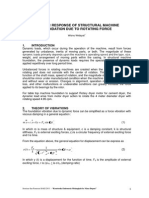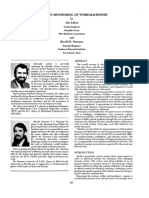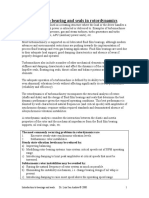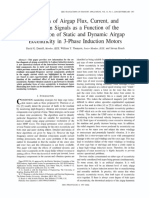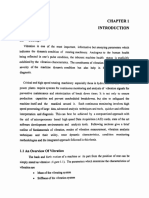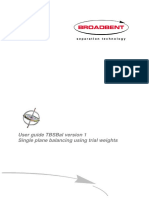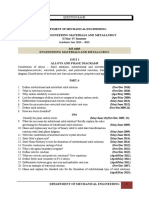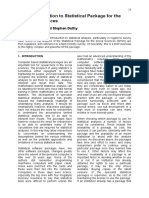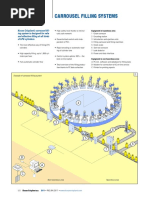Critical Speed PDF
Critical Speed PDF
Uploaded by
Paramasivam VeerappanCopyright:
Available Formats
Critical Speed PDF
Critical Speed PDF
Uploaded by
Paramasivam VeerappanOriginal Title
Copyright
Available Formats
Share this document
Did you find this document useful?
Is this content inappropriate?
Copyright:
Available Formats
Critical Speed PDF
Critical Speed PDF
Uploaded by
Paramasivam VeerappanCopyright:
Available Formats
International Review of Applied Engineering Research.
ISSN 2248-9967 Volume 4, Number 3 (2014), pp. 241-250
Research India Publications
http://www.ripublication.com/iraer.htm
A Review of Rotating Machinery Critical Speeds and
Modes of Vibrations
Mili J. Hota and D.P. Vakharia
Sardar Vallabhbhai National Institute of Technology, Surat.
Abstract
The aim of this paper is to present a practical understanding of
terminology and behavior based in visualizing how a shaft vibrates,
and examining issues that affect vibration. The paper also presents the
synchronous critical speeds of rotor-bearing systems. The majority of
attention is on the unbalance excitation of natural frequencies with
whirling and spinning in same direction. Most rotor dynamic analyses
typically ignore the potential for critical speeds to be created by
traversing a backward processional whirl mode. While not commonly
recognized, a backward mode can be excited using unbalance as the
driving force. One of the major areas of interest in the modern-day
condition monitoring of rotating machinery is that of vibration. If a
fault develops and goes undetected, then, at best, the problem will not
be too serious and can be remedied quickly and cheaply; at worst, it
may result in expensive damage and down-time, injury, or even loss of
life. By measurement and analysis of the vibration of rotating
machinery, it is possible to detect and locate important faults such as
mass unbalance, shaft alignment, rub and cracked shafts vibration. This
paper helps to learn the basic modes of vibrations and predicting
critical speed by practical approach and also concludes some important
practical recommendations on rotor-bearing design so that unique
critical speed situation may be avoided.
Index Terms: Critical speed, Gyroscopic, high-speed, natural
Frequency, resonances, stiffness, vibration mode.
1. Introduction
The unique characteristics of rotating machinery vibration, the terminology and
behavior of a machine are been discussed. Like most specialty areas, there are a
242
Mili J. Hota & D.P. Vakharia
number of excellent texts, but it can be difficult to quickly pull out the practical insight
needed. At the other end of the spectrum, there is also a large number of
troubleshooting resources that focus on identification of problems and characteristics,
but only offer limited insight. Discussion of recent combined experimental and
analytical effort raised the possibility of an article that would attempt to provide a
deeper insight into some of the basic characteristics of rotating machinery vibration
from a less mathematical perspective.
Thus in this article several issues that are basic to an understanding of rotating
machinery vibration are been discussed:
What are critical speeds?
How do critical speeds relate to resonances and natural frequencies?
How do natural frequencies change as the shaft rotational speed changes?
How are shaft rotational natural frequencies different from more familiar
natural frequencies and modes in structures?
What effects do bearing characteristics have?
2. Vibration Intuition
2.1 A Brief Review of Structural Vibration
As engineers, we learn that vibration characteristics are determined by a structures
mass and stiffness values, with damping (ability to dissipate vibrational energy)
playing an integral role by controlling amplitudes. This education generally starts with
the simplest possible system a rigid mass attached to a spring as shown in Fig. 1[1].
With this simple system, we quantify our intuition about vibrational frequency (heavier
objects result in lower frequency, stiffer springs yield higher frequency). After some
work, we reach the conclusion that the free vibration frequency is controlled by the
square root of the ratio of stiffness to mass as shown in Fig. 1. We could then add a
viscous damper parallel with the spring, and provide a sinusoidal force as shown in
Fig. 2[3]. By carefully applying a constant amplitude sinusoidal force that slowly
increases in frequency and recording the amplitude of the motion, we could then
generate the classic normalized frequency responses of a spring-mass-damper system.
By repeating the test with a variety of dampers, the classic frequency response shown
in Fig. 3 can be developed. Assuming we knew the mass, stiffness and damping of our
system, this response is also predicted quite well by the standard frequency domain
solution to the differential equation of motion for this system shown in Equation 1[2].
Amplitude =
F0
k
2
m 2 c
1
+
(1)
There are several noteworthy points about these frequency responses. The first is
that at low excitation frequencies, the response amplitude is roughly constant and
greater than zero. The amplitude is governed by the ratio of the applied force to the
A Review of Rootating Macchinery Crittical Speedss and Modess of Vibratioons
243
spriing stiffnesss [6]. The second
s
is thhat the respo
onse increases to a peaak, then rap
pidly
decrreases in the low and mediuum dampin
ng cases. This peakk frequency
y is
apprroximately the dampedd natural freequency, (m
more techniccally correcct, it is the peak
p
respponse frequuency, whicch moves down in frequency
f
f
from
the ddamped nattural
freqquency as damping
d
inccreases). Thhe system iss said to bee in resonaance when
n the
exciitation frequuency matchhes the dam
mped naturall frequency.. Very largee amplitudess are
posssible when the excitattion frequenncy is closee to this freequency. Thhe amplitud
de is
conttrolled by the
t magnituude of the damping
d
(more dampinng reduces tthe amplitud
des).
Thee high dampping case haas no real peak,
p
and is said to be overdampeed. Finally
y, the
ampplitude continues to deccrease for alll higher freequencies. These
T
characcteristics wiill be
conttrasted withh the response of a rootating systeem to unbaalance excittation in a later
secttion. Movinng from the simple singgle mass system to muultimass systtems, the baasics
do not
n change. Natural freqquencies aree still primaarily relatedd to mass and stiffness, with
som
me changes due to daamping. Exxcitation freequency eqqual to a ddamped nattural
freqquency is a resonance.. Excitationn near a ressonance cann result in llarge ampliitude
respponses. Respponse amplitudes are controlled
c
by
y damping. With enouggh damping
g, the
respponse peak can be com
mpletely elim
minated. The biggest chhange is thaat there are now
mulltiple naturaal frequenccies and that each nattural frequeency has a correspon
nding
uniqque mode-shape wiith differennt parts off the structture vibratinng at diffeerent
ampplitudes andd differing phases
p
relative to one an
nother.
F 1: Simpple spring-m
Fig.
mass- system
m
with annd without damper.
d
Fig. 3:
3 Frequencyy response oof spring mass
dampeer system to constant am
mplitude forrce.
Figg. 2: Free reesponse of Simple
S
sprinng- Fig. 4: Basic macchine modell cross sectiion.
m
masssystem
m
2444
Milli J. Hota & D.P. Vakh
haria
2.2 A Simple Rotating
R
M
Machine
Thee rotating machinery
m
e
equivalent
to the sing
gle spring-m
mass dampper system is a
lum
mped mass on
o a massless, elastic shaft. Thiss model, hiistorically rreferred to as a
Jefffcott or Laval model, is a singlee degree of freedom syystem that iss generally used
u
to inntroduce rottor dynamicc characteriistics. This model, shoown in crosss-section in Fig.
4[5]], consists of
o a rigid ceentral disk, a shaft (witth stiffness and mass) and two rig
gidly
mouunted bearinngs.
Non
nrotating Dynamics
D
Supppose that ouur simple machine
m
is not
n spinning
g, that the bearings havve essentiallly no
dam
mping, and that
t the bearrings have equal
e
radial stiffness inn the verticaal and horizo
ontal
direections (all typical charracteristics of ball beaarings). Let us also supppose that there
t
are three versioons of this machine,
m
onne each with
h soft, interrmediate and stiff beariings.
Through eitheer analysis or a moodal test, we wouldd find a set of nattural
freqquencies/moodes. At eaach frequenncy, the mo
otion is plaanar (just liike the pin
nnedpinnned beam). This behaviior is what we
w would expect
e
from a static struucture. Fig. 5[3]
show
ws the first three modee shapes andd frequenciees for the thhree bearingg stiffnessess. As
withh the beam
m, the thickk line show
ws the shafft centerlinne shape at the maxim
mum
dispplacement. As
A it vibrattes, it movees from thiss position too the same location on
n the
oppposite side of
o the dispplaced centeerline, and back. Notee that the rratio of beaaring
stifffness to shafft stiffness has
h a signifi
ficant impacct on the moode-shapes. For the softt and
inteermediate beearings, thee shaft doess not bend very muchh in the low
wer two mo
odes.
Thuus, these aree generally referred to as rigid rotor
r
modees. As the bbearing stifffness
incrreases (or ass shaft stiffn
fness decreaases), the am
mount of shhaft bendingg increases. One
inteeresting featuure of the mode
m
shapess is how thee central disk moves. Inn the first mode,
m
the disk translaates withouut rocking. In
I the secon
nd mode, itt rocks withhout translaation.
Thiss general chharacteristicc repeats ass the frequeency increaases. If we m
moved the disk
off-center, we would findd that the motion
m
is a mix of trannslation andd rocking. This
charracteristic will
w give rise to some interesting
i
behavior
b
onnce the shaft
ft starts rotaating.
If we
w repeatedd the constant amplituude excitatiion frequenncy sweep eexperiment,, we
wouuld get veryy similar beehavior as with
w the spring-mass-ddamper systtem plot sh
hown
prevviously. Theere would be
b a spring-ccontrolled deflection
d
att low frequeencies, a peaak in
ampplitude, and adecay in amplitude
a
w further increases
with
i
inn frequency.
Fiig. 5: Modee shapes verrsus bearingg
stiffness,, shaft not rootating.
Fig. 6: Shaft rotatiing at 10 rppm,1st modee
sh
hape and freequencies inn rpm.
A Review of Rootating Macchinery Crittical Speedss and Modess of Vibratioons
Fig. 7:
7 Whirl sennse.
245
Fig. 8:
8 Effect of operating
o
sppeed on 1st
m
modes.
3. Rotating Dynamiccs Cylin
ndrical Mo
odes
Sincce rotating machinery
m
has to rotatte to do useeful work, leets consideer what happ
pens
to thhe first modde of our rootor once itt is spinning
g. Again, we
w will havee three diffeerent
verssions with increasing
i
b
bearing
stifffness, and we will asssume our suupport bearrings
have equal stifffness in alll radial direections. Lets repeat ouur analysis/m
modal test with
the shaft spinniing at 10 rppm, and loook at the frequency andd mode shappe of the low
west
b
show
ws the frequ
uencies and mode shapees or the low
west
natuural frequenncy. Fig. 6 below
modde of the thhree machines. Note that
t
the shaape of the motion hass changed. The
freqquencies, thoough, are quuite close too the nonrottating first mode.
m
As in the nonrotaating
casee, the beariing stiffnesss to shaft stiffness
s
ratiio has a strrong impacct on the modem
shappe. Again, the case wiith almost no
n shaft beending is reeferred to as a rigid mode.
m
Theese modes look very much
m
like the non ro
otation moddes, but theey now inv
volve
circcular motionn rather thann planar mottion.
To visualizze how the rotor
r
is movving, first im
magine swinging a jum
mp rope aro
ound.
Thee rope tracees the outliine of a buulging cylin
nder. Thus, this modee is sometiimes
refeerred to as a cylindriccal mode. Viewed fro
om the fronnt, the ropee appears to
o be
bouuncing up and
a down. Thus, this mode is also
a
sometimes called a bouncee or
trannslatory mode. The whhirling motiion of the ro
otor (the juumprope m
motion) can be
b in
the same directtion as the shafts
s
rotattion or in the opposite direction.
d
This gives risse to
the labels forw
ward whirl and backkward whirl.. Fig. 7[8] shows rotoor cross secttions
overr the coursse of time for both syynchronous forward annd synchroonous backw
ward
whiirl. Note thhat for forw
ward whirl, a point on the surfacee of the rotoor moves in
n the
sam
me direction as the whirl.
Thus, for syynchronous forward whhirl (unbalan
nce excitation, for exam
mple), a poiint at
the outside of the rotor reemains to the
t outside of the whirrl orbit[9]. With backw
ward
whiirl, on the other
o
hand, a point at the surface of the rootor moves in the oppo
osite
direection as thee whirl to the inside of the
t whirl orrbit during thhe whirl.
To see how
w a wider raange of shafft speeds ch
hanges the situation,
s
wee could perfform
the analysis/moodal test wiith a range of
o shaft speeeds from non
n spinningg to high sp
peed.
We could thenn follow the forward annd backward
d frequencies associateed with the first
modde. Fig. 8 plots
p
the foorward (red line) and backward
b
(
(black
dasheed line) natural
246
Mili J. Hota & D.P. Vakharia
frequencies over a wide shaft speed range. This plot is often referred to as a Campbell
Diagram. From this figure, we can see that the frequencies of this cylindrical mode do
not change very much over the speed range. The backward whirl mode drops slightly,
and the forward whirl mode increases slightly (most noticeably in the high stiffness
case). The reason for this change will be explored in the next section.
4. Rotating Dynamics Conical Mode
Now that we have explored the cylindrical mode, lets look at the second set of modes.
Fig. 9 shows the next frequencies and mode-shapes for the three machines. The
frequencies are close to the nonrotating modes where the disk was rocking without
translating. The modes look a lot like the nonrotating modes, but again involve circular
motion rather than planar motion. To visualize how the rotor is moving, imagine
holding a rod stationary in the center, and moving it so that the ends trace out two
circles. The rod traces the outline of two bulging cones pointed at the center of the rod.
Thus, this mode is sometimes referred to as a conical mode. Viewed from the side,
the rod appears to be rocking up and down around the center, with the left side being
out-of-phase from that on the right. Thus, this mode is also sometimes called a rock
mode or a pitch mode.
As with the first mode and the nonrotating modes, the low bearing stiffness mode
is generally referred to as a rigid mode, and a high bearing stiffness pulls in the rotor
ends. As with the cylindrical mode, the whirl can be in the same direction as the rotors
spin (forward whirl), or the opposite direction (backward whirl).
To see the effects of changing shaft speeds, we could again perform the
analysis/modal test from non spinning to a high spin speed and follow the two
frequencies associated with the conical mode. Fig. 10 plots the forward (red line) and
backward (black dashed line) natural frequencies over a wide speed range. From this
figure, we can see that the frequencies of the conical modes do change over the speed
range. The backward mode drops in frequency, while the forward mode increases.
The explanation for this surprising behavior is a gyroscopic effect that occurs
whenever the mode shape has an angular (conical/rocking) component. First consider
forward whirl. As shaft speed increases, the gyroscopic effects essentially act like an
increasingly stiff spring on the central disk for the rocking motion. Increasing stiffness
acts to increase the natural frequency. For backward whirl, the effect is reversed.
Increasing rotor spin speed acts to reduce the effective stiffness, thus reducing the
natural frequency (as a side note, the gyroscopic terms are generally written as a skewsymmetric matrix added to the damping matrix the net result, though, is a stiffening/
softening effect). In the case of the cylindrical modes, very little effect of the
gyroscopic terms was noted, since the center disk was whirling without any conical
motion. Without the conical motion, the gyroscopic effects do not appear. Thus, for the
soft bearing case, which has a very cylindrical motion, no effect was observed, while
for the stiff bearing case, which has a bulging cylinder (and thus conical type motion
near the bearings), a slight effect was noted.
A Review of Rootating Macchinery Crittical Speedss and Modess of Vibratioons
247
Fig. 9: Shaft rotating
r
at 10
1 rpm,2nd mode Fig
g. 10: Effectt of opperatting speed on
o
shapes and
a frequenncies in rpm
m
2nd naatural frequeencies
Fig. 11: Coomparison of
F
o different disk
d
properties, center diskk configuration
Fig
g. 11: Compparison of ddifferent dissk
properties, overhung
o
coonfiguration
2.3 Exploring Gyroscopic and Masss Effects
Now
w that we have seen how gyroscopic effeccts act to change the rotating natural
freqquency wheenever theree is motion with some conical com
mponent, leets look at two
sets of single disk rotors. In
I each casee, there will be a nominnal rotor, a hheavy disk ro
otor,
d
loonger disk rotor.
r
The heavy
h
disk differs
d
from
m the nominal in
and a smaller diameter,
thatt a fictitiouss mass equaal to the diskk mass is atttached (i.e., mass incrreases, but mass
m
mom
ment of ineertia is unchhanged). Thhe smaller, longer dissk is the saame weight,, but
smaaller in diam
meter and greater
g
in length.
l
This smaller disk
d
has redduced the mass
m
mom
ment of ineertia about the
t spin axxis (polar moment Ipp) by a facttor of 0.53, and
reduuces the mass
m
momennt of inertiia about th
he disk diam
meter (Id) by a facto
or of
0.655[11].
For the firsst case, letss use a symm
metric, centter disk rotoor again. Figg. 12 showss the
threee models, and
a the threee sets of natural
n
freq
quencies verrsus speed. Comparing
g the
nom
minal modell to the two modified veersions, notee that:
The inccreased masss lowers thhe first mode frequenccies (mass is at a poin
nt of
large whirling
w
motiion).
The inccreased masss leaves thee second mo
ode unchanged (increased mass iss at a
point off little whirlling motion)).
248
Mili J. Hota & D.P. Vakharia
The reduced mass moment of inertia version does not change the first mode
(disk center of gravity has very little conical motion).
The reduced mass moment of inertia increases the frequency of the second
mode, and decreases the strength of the gyroscopic effect (disk center of
gravity has substantial conical motion).
For the second case, lets move the disk to the end, and move the bearing inboard
to result in an overhung rotor with the same mass and overall length. Fig. 14 shows the
three models and the three sets of natural frequencies versus speed. Comparing the
nominal model to the two modified versions, the important things to note are:
The increased mass lowers the first mode frequencies and very slightly lowers the
second mode frequencies.
The reduced mass moment of inertia version increases the frequency of both the
first and second modes, and decreases the strength of the gyroscopic effect.
If we looked at the mode shapes and these plots, we would again see that the
reasons are the same as for the center disk rotor. Changes in affect the natural
frequency of that mode but have little effect if it is at a node. Changes to mass moment
of inertia at a location of large whirl orbit, on the other hand, have little effect.
Changes to mass moment of inertia at a node with large conical motions have a strong
effect on the corresponding mode. Although not entirely obvious from the plots
presented, changes in the ratio of polar mass moment of inertia to diametric mass
moment of inertia change the strength of the gyroscopic effect. Indeed, for a very thin
disk (a large ratio), the forward conical mode increases in speed so rapidly that the
frequency will always be greater than the running speed. Indeed, there will be no
conical critical speed as defined below.
2.4 Critical Speeds
With some insight into rotating machinery modes, we can move on to critical speeds.
The American Petroleum Institute(API), in API publication 684 (First Edition, 1996),
defines critical speeds and resonances as follows:
Critical Speed A shaft rotational speed that corresponds to the peak of a
noncritically damped (amplification factor > 2.5) rotor system resonance
frequency. The frequency location of the critical speed is defined as the
frequency of the peak vibration response as defined by a Bod plot (for
unbalance excitation).
Resonance The manner in which a rotor vibrates when the frequency of a
harmonic (periodic) forcing function coincides with a natural frequency of the
rotor system.
Thus, whenever the rotor speed passes through a speed where a rotor with the
appropriate unbalance distribution excites a corresponding damped natural frequency,
and the output of a properly placed sensor displays a distinct peak in response versus
speed, the machine has passed through a critical speed. Critical speeds could also be
referred to as peak response speeds.
A Review of Rootating Macchinery Crittical Speedss and Modess of Vibratioons
249
Numericallly, these are
a distinct from critiical speedss as defineed by the API
speccification.
As a criticaal speed exaample, we will
w use thee medium sttiffness, cennter disk mo
odel,
and add an unbbalance distrribution thaat excites thee first three modes. Wee will also add
a a
smaall amount of dampinng at the bearings.
b
Fig.
F
13 shoows the reesulting verrtical
dispplacement reesponse duee to the unbbalance forcces at the leeft bearing aas a functio
on of
speeed. The dam
mped naturaal frequencyy versus speeed plot (Caampbell Diaagram) is drrawn
beloow for referrence.
Fig. 13: Com
mparison bettween naturral Fig. 14:
1 Phase reelationship oof center off
frequenciees and criticcal speeds.
orbit veersus center of mass thrrough critical
s
speed.
3.1 Characteriistics of Un
nbalance Exxcitation
A careful compparison of thhe previouss set of unbalance response plot inn Figures 13
3 for
the center diskk machine, and
a the freqquency resp
ponse plot for
fo the sprinng-mass-dam
mper
struucture in Figg. 3 reveals two
t significcant differen
nces. At low
w frequenciees, the structural
plott shows a reesponse equaal to the staatic responsee, whereas the
t unbalancce response plot
startts out with no responsse. Likewisse, at higheer frequenciies, the struuctural response
decaays, while thhe unbalancce response tends to a constant
c
valuue at higherr speeds.
These two differences are the ressult of the frequency
f
d
dependency
of the consstant
ampplitude sinussoidal forcee versus unbbalance exciitation.
The struuctural exciitation was assumed to be a constaant force at all frequen
ncies,
while unbalance
u
exxcitation haas a speed-squared. At zero rpm, thhere is no force
f
from unnbalance exccitation, whhich explain
ns the first diifference nooted.
The seccond differrence thaat the unbaalance respoonse amplitude goes to a
constannt value abovve the criticcal speed has
h a more interesting
i
eexplanation.
We can seee what occuurs by referring to Fig. 14. This Figg. plots the relative ang
gular
relaationship beetween the unbalance
u
location and
d rotor response as rotor speed paasses
throough a criticcal speed. Below
B
the critical
c
speeed, the unbaalance acts to pull the disk
out into an orbbit that grow
ws increasingly large with speed. At the criitical speed, the
rotoor response lags the unbalance by approxiimately 90. Howeveer after passsing
250
Mili J. Hota & D.P. Vakharia
through the critical speed, the phase between the unbalance force and the response
direction has changed by 180. As a result, the disk now rotates around the mass center
of the disk/unbalance. Once the disk achieves this state, further increases in speed do
not change the amplitude until the effects of the next mode are observed.
5. Conclusions
It was shown that cylindrical rotor modes are not influenced by gyroscopic effects and
remain at a fairly constant frequency versus rotor speed. Conversely, conical rotor
modes are indeed influenced and caused to split into forward and backward whirl
components that respectively increase and decrease in frequency with increased rotor
speed.
References
[1]
[2]
[3]
[4]
[5]
[6]
[7]
[8]
[9]
[10]
[11]
[12]
[13]
[14]
[15]
Michael I. Friswell et al. Dynamics of rotating machines, 1 edition 2010. {79}
AKPOBI, J.A.; OVUWORIE, G.C. ComputerAided Design of the Critical Speed
of Shafts J. Appl. Sci. Environ. Manage. December, 2008 Vol. 12(4) 79 86
Den Hartog, J. P. Mechanical Vibrations, 4th ed. New York:McGraw-Hill,1996.
Eshleman, R. Torsional vibration of machine systems. Proceedings of the 6th Turbo
machinery Symposium, Texas A&M University, 2010, p.13.
Farouk Hamdoon O, Application of finite element package for modeling rotating
machinery vibration, Engg and Tech Journal, vol. 27, No 12, 2009.
Henrich Sprysl, Gunter Ebi, Bearing stiffness determination through vibration
analysis of shaft line of hydro power plant, International Journal of hydro power &
dams, 1998, pp. 437-447
John M Vance, Brain T Murphy, Critical speeds of turbo machinery computer
prediction vs. Experimental measurements, ASME Journal of Engg for power, 1981,
pp.141-145.
J.S. Rao. Rotor Dynamics. Wiley Eastern Ltd., 1983.
Lund, J. W. Destabilization of Rotors from Friction in Internal Joints with Microslip. International Conference in Rotordynamics, JSME, 1986, pp. 487491.
Mathuria P.H, Sainagar A, Lateral natural frequency of a shaft rotor system by the
transfer matrix method Citeseerxa scientific literature digital library, Pennsylvania
state University. 2010
Michael I. Friswell et al. Dynamics of rotating machines, 1 edition 2010. {79}
P. Srinivasan. Mechanica Vibration and Analysis. Tata McGraw-Hill Co., 1982.
Steidel, R. F., Jr. An Introduction to Mechanical Vibrations. New York: Wiley, 1989.
Thomson, W. T. Theory of Vibration with Applications, 4th ed. Englewood Cliffs,
NJ: Prentice Hall, 1993.
Vance, J. M. and French, R. S. Measurement of torsional vibration in rotating
machinery. Journal of Mechanisms, Transmissions, and Automation in Design
108:565577 (1986).
You might also like
- Correlation Between Belt Natural Frequencies and Vibration SpectraNo ratings yetCorrelation Between Belt Natural Frequencies and Vibration Spectra7 pages
- Bode Diagrams of Transfer Functions and Impedances: ECEN 2260 Supplementary Notes R. W. EricksonNo ratings yetBode Diagrams of Transfer Functions and Impedances: ECEN 2260 Supplementary Notes R. W. Erickson49 pages
- Pulsating Torque Minimization Techniques For Permanent Magnet AC Motor Drives - A ReviewNo ratings yetPulsating Torque Minimization Techniques For Permanent Magnet AC Motor Drives - A Review10 pages
- An Endusers Guide To Centrifugal Pump RotordynamicsNo ratings yetAn Endusers Guide To Centrifugal Pump Rotordynamics16 pages
- Vibration Analysis Recip Compressors PDFNo ratings yetVibration Analysis Recip Compressors PDF4 pages
- Vibration Analysis Techniques For Gearbox Diagnostic: A ReviewNo ratings yetVibration Analysis Techniques For Gearbox Diagnostic: A Review10 pages
- Introduction To Bearing and Seals in Rotordynamics: The Most Commonly Recurring Problems in Rotordynamics AreNo ratings yetIntroduction To Bearing and Seals in Rotordynamics: The Most Commonly Recurring Problems in Rotordynamics Are15 pages
- Vibration Tolerance Rathbone Power Plant Engineering 1939 11 Vol 43 Iss 11 - CompressedNo ratings yetVibration Tolerance Rathbone Power Plant Engineering 1939 11 Vol 43 Iss 11 - Compressed4 pages
- Chapter 1.1-Power Transmission (Belt Drive)No ratings yetChapter 1.1-Power Transmission (Belt Drive)48 pages
- Rotor Dynamics of Aircraft Gas Turbine EnginesNo ratings yetRotor Dynamics of Aircraft Gas Turbine Engines5 pages
- A I RS: David G. Dorrell, William ThomsonNo ratings yetA I RS: David G. Dorrell, William Thomson11 pages
- 1.0 Concept: Stiffness of The Vibration SystemNo ratings yet1.0 Concept: Stiffness of The Vibration System10 pages
- Rotor Dynamic Modelling As A Powerfull Tool For Vibrartion Analysis of Large TurbomachineryIFTOMM 2010No ratings yetRotor Dynamic Modelling As A Powerfull Tool For Vibrartion Analysis of Large TurbomachineryIFTOMM 20107 pages
- Full Paper 0069 Submitter 0073 Tian XiangeTian Submission 23-07-2014No ratings yetFull Paper 0069 Submitter 0073 Tian XiangeTian Submission 23-07-20146 pages
- As 2625.4-2003 Mechanical Vibration - Evaluation of Machine Vibration by Measurements On Non-Rotating Parts INo ratings yetAs 2625.4-2003 Mechanical Vibration - Evaluation of Machine Vibration by Measurements On Non-Rotating Parts I8 pages
- PS10 Karadzic-Bergant-Vukoslavcevic RevisedNo ratings yetPS10 Karadzic-Bergant-Vukoslavcevic Revised15 pages
- Basic-Engineering - Electrical EngineeringNo ratings yetBasic-Engineering - Electrical Engineering227 pages
- Pagano1995 - Dynamic Behaviour of Tilting-Pad Journal BearingsNo ratings yetPagano1995 - Dynamic Behaviour of Tilting-Pad Journal Bearings11 pages
- Modal Balancing of Flexible Rotors With Bow and Distributed UnbalanceNo ratings yetModal Balancing of Flexible Rotors With Bow and Distributed Unbalance18 pages
- 3300 XL NSV Proximity Transducer System DatasheetNo ratings yet3300 XL NSV Proximity Transducer System Datasheet31 pages
- Effect or Reynolds Number and Surface Roughness On The Efficiency of Centrifugal PumpsNo ratings yetEffect or Reynolds Number and Surface Roughness On The Efficiency of Centrifugal Pumps10 pages
- Michael M. Calistrat: Safety, Application, and Service Factors As Applied To Shaft Couplings byNo ratings yetMichael M. Calistrat: Safety, Application, and Service Factors As Applied To Shaft Couplings by8 pages
- Performance Monitoring of Vibration in Belt Conveyor System: S.Ojha, D. Sarangi, B.K. Pal, B.B. BiswalNo ratings yetPerformance Monitoring of Vibration in Belt Conveyor System: S.Ojha, D. Sarangi, B.K. Pal, B.B. Biswal10 pages
- Shock Response Spectrum at Low FrequenciesNo ratings yetShock Response Spectrum at Low Frequencies10 pages
- List of Hydroelectric Power Station FailuresNo ratings yetList of Hydroelectric Power Station Failures4 pages
- A Review of Tilting Pad Bearing Theory PDF100% (1)A Review of Tilting Pad Bearing Theory PDF24 pages
- Vibration Monitoring Identifies Steam Turbine Seal Rub Sharma100% (1)Vibration Monitoring Identifies Steam Turbine Seal Rub Sharma11 pages
- A Treatise On Vibration Diagnostic Plots of MachineryNo ratings yetA Treatise On Vibration Diagnostic Plots of Machinery10 pages
- AGMA Technical Paper Sumitomo Cycloidal Vibration Analysis100% (1)AGMA Technical Paper Sumitomo Cycloidal Vibration Analysis25 pages
- 0505swan A Practical Review of Rotating Machinery Critical Speeds and ModesNo ratings yet0505swan A Practical Review of Rotating Machinery Critical Speeds and Modes8 pages
- Engineering Materials and Metallurgy QBNo ratings yetEngineering Materials and Metallurgy QB13 pages
- Janitor JV500 Backpack Manual 11500210 V9No ratings yetJanitor JV500 Backpack Manual 11500210 V911 pages
- Midmark Ultra-Series Dental Chairs: ModelsNo ratings yetMidmark Ultra-Series Dental Chairs: Models48 pages
- Contract Labour (Regulation & Abolition Act)No ratings yetContract Labour (Regulation & Abolition Act)11 pages
- Widens Norcilus, A072 041 927 (BIA June 2, 2017)No ratings yetWidens Norcilus, A072 041 927 (BIA June 2, 2017)16 pages
- SQL 2005/2008 DBA (Database Administrator) : Kebutuhan: 1 OrangNo ratings yetSQL 2005/2008 DBA (Database Administrator) : Kebutuhan: 1 Orang4 pages
- Jose Cotarelo v. Village of Sleepy Hollow Police Department, Jimmy Warren, Jr., Phillip Zegarelli, Mario Defelice, Village Trustee, Robert Higle, Richard Ziejack, Patricia Rodriguez, Daniel Stever, James Hart, Dwight Douglas, Village Administrator, All Sued in Their Individual Capacities, Docket No. 04-4627-Cv, 460 F.3d 247, 2d Cir. (2006)No ratings yetJose Cotarelo v. Village of Sleepy Hollow Police Department, Jimmy Warren, Jr., Phillip Zegarelli, Mario Defelice, Village Trustee, Robert Higle, Richard Ziejack, Patricia Rodriguez, Daniel Stever, James Hart, Dwight Douglas, Village Administrator, All Sued in Their Individual Capacities, Docket No. 04-4627-Cv, 460 F.3d 247, 2d Cir. (2006)7 pages
- Implementing Cisco Service Provider Next-Generation Core Network ServicesNo ratings yetImplementing Cisco Service Provider Next-Generation Core Network Services24 pages
- Embedded System 16 Marks University QuestionsNo ratings yetEmbedded System 16 Marks University Questions2 pages
- PO Acknowledgments - Girls Care House - HailNo ratings yetPO Acknowledgments - Girls Care House - Hail1 page
- Augmented Reality - Ishika - PDF - Ishika ShrutiNo ratings yetAugmented Reality - Ishika - PDF - Ishika Shruti16 pages
- An Introduction To Statistical Package For The Social SciencesNo ratings yetAn Introduction To Statistical Package For The Social Sciences12 pages
- Correlation Between Belt Natural Frequencies and Vibration SpectraCorrelation Between Belt Natural Frequencies and Vibration Spectra
- Bode Diagrams of Transfer Functions and Impedances: ECEN 2260 Supplementary Notes R. W. EricksonBode Diagrams of Transfer Functions and Impedances: ECEN 2260 Supplementary Notes R. W. Erickson
- Pulsating Torque Minimization Techniques For Permanent Magnet AC Motor Drives - A ReviewPulsating Torque Minimization Techniques For Permanent Magnet AC Motor Drives - A Review
- An Endusers Guide To Centrifugal Pump RotordynamicsAn Endusers Guide To Centrifugal Pump Rotordynamics
- Vibration Analysis Techniques For Gearbox Diagnostic: A ReviewVibration Analysis Techniques For Gearbox Diagnostic: A Review
- Introduction To Bearing and Seals in Rotordynamics: The Most Commonly Recurring Problems in Rotordynamics AreIntroduction To Bearing and Seals in Rotordynamics: The Most Commonly Recurring Problems in Rotordynamics Are
- Vibration Tolerance Rathbone Power Plant Engineering 1939 11 Vol 43 Iss 11 - CompressedVibration Tolerance Rathbone Power Plant Engineering 1939 11 Vol 43 Iss 11 - Compressed
- Rotor Dynamic Modelling As A Powerfull Tool For Vibrartion Analysis of Large TurbomachineryIFTOMM 2010Rotor Dynamic Modelling As A Powerfull Tool For Vibrartion Analysis of Large TurbomachineryIFTOMM 2010
- Full Paper 0069 Submitter 0073 Tian XiangeTian Submission 23-07-2014Full Paper 0069 Submitter 0073 Tian XiangeTian Submission 23-07-2014
- As 2625.4-2003 Mechanical Vibration - Evaluation of Machine Vibration by Measurements On Non-Rotating Parts IAs 2625.4-2003 Mechanical Vibration - Evaluation of Machine Vibration by Measurements On Non-Rotating Parts I
- Pagano1995 - Dynamic Behaviour of Tilting-Pad Journal BearingsPagano1995 - Dynamic Behaviour of Tilting-Pad Journal Bearings
- Modal Balancing of Flexible Rotors With Bow and Distributed UnbalanceModal Balancing of Flexible Rotors With Bow and Distributed Unbalance
- Effect or Reynolds Number and Surface Roughness On The Efficiency of Centrifugal PumpsEffect or Reynolds Number and Surface Roughness On The Efficiency of Centrifugal Pumps
- Michael M. Calistrat: Safety, Application, and Service Factors As Applied To Shaft Couplings byMichael M. Calistrat: Safety, Application, and Service Factors As Applied To Shaft Couplings by
- Performance Monitoring of Vibration in Belt Conveyor System: S.Ojha, D. Sarangi, B.K. Pal, B.B. BiswalPerformance Monitoring of Vibration in Belt Conveyor System: S.Ojha, D. Sarangi, B.K. Pal, B.B. Biswal
- Vibration Monitoring Identifies Steam Turbine Seal Rub SharmaVibration Monitoring Identifies Steam Turbine Seal Rub Sharma
- A Treatise On Vibration Diagnostic Plots of MachineryA Treatise On Vibration Diagnostic Plots of Machinery
- AGMA Technical Paper Sumitomo Cycloidal Vibration AnalysisAGMA Technical Paper Sumitomo Cycloidal Vibration Analysis
- 0505swan A Practical Review of Rotating Machinery Critical Speeds and Modes0505swan A Practical Review of Rotating Machinery Critical Speeds and Modes
- SQL 2005/2008 DBA (Database Administrator) : Kebutuhan: 1 OrangSQL 2005/2008 DBA (Database Administrator) : Kebutuhan: 1 Orang
- Jose Cotarelo v. Village of Sleepy Hollow Police Department, Jimmy Warren, Jr., Phillip Zegarelli, Mario Defelice, Village Trustee, Robert Higle, Richard Ziejack, Patricia Rodriguez, Daniel Stever, James Hart, Dwight Douglas, Village Administrator, All Sued in Their Individual Capacities, Docket No. 04-4627-Cv, 460 F.3d 247, 2d Cir. (2006)Jose Cotarelo v. Village of Sleepy Hollow Police Department, Jimmy Warren, Jr., Phillip Zegarelli, Mario Defelice, Village Trustee, Robert Higle, Richard Ziejack, Patricia Rodriguez, Daniel Stever, James Hart, Dwight Douglas, Village Administrator, All Sued in Their Individual Capacities, Docket No. 04-4627-Cv, 460 F.3d 247, 2d Cir. (2006)
- Implementing Cisco Service Provider Next-Generation Core Network ServicesImplementing Cisco Service Provider Next-Generation Core Network Services
- An Introduction To Statistical Package For The Social SciencesAn Introduction To Statistical Package For The Social Sciences



